In This Work of Art Which of the Following Can Be Observed?
Articles and Features
Gesamtkunstwerk.
The Full Work Of Art Through The Ages.
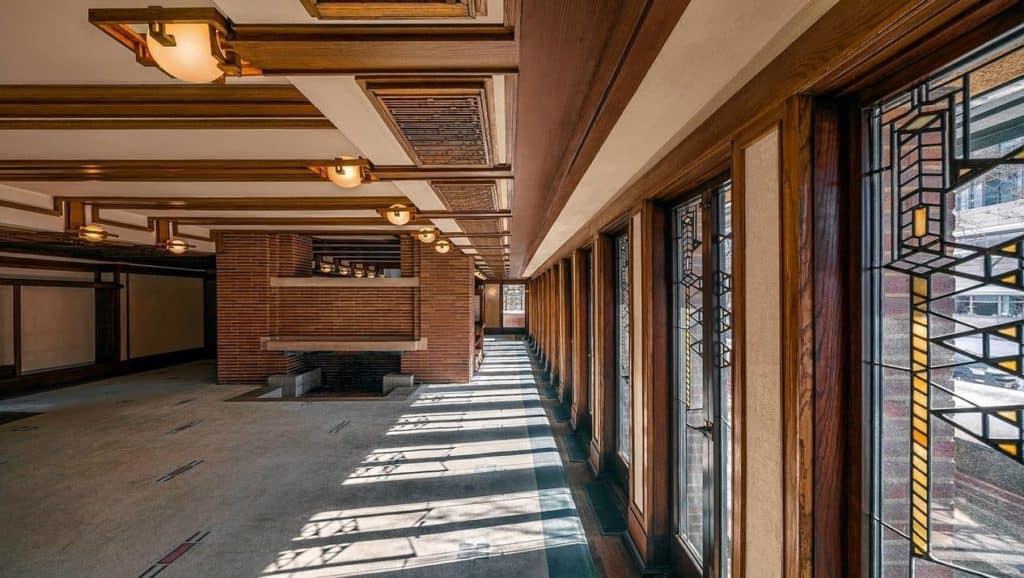
By Naomi Martin
Introduction
Gesamtkunstwerk, meaning literally 'total piece of work of art', was originally intended to mean that all types of art, including painting, music, architecture, literature or performances could be collated into one interrelated field of study, project and report, then that an overarching design schema would cover all elements of a creation.
More than commonly, the term has been practical to architectural projects where the lead designer carries a responsibility non just for the building, but the interiors, landscape and all details, furniture and even fittings, as far down the scale to include minutiae as seemingly inconsequential equally door handles.
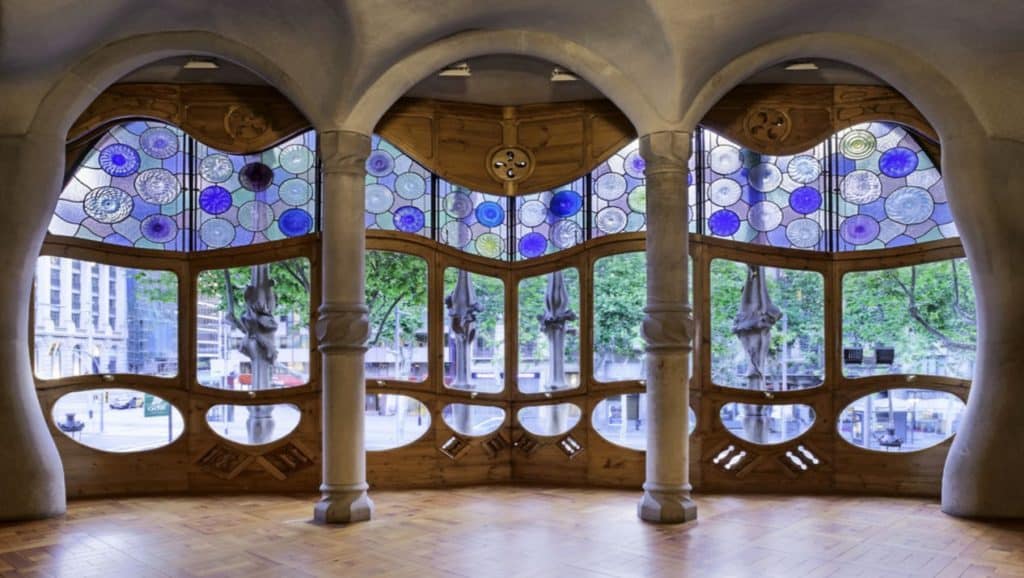
Coining the term
To elucidate the concept of Gesamtkunstwerk without confronting the inadequacies of translation might be an arduous task, as the German word knows no straight translation into English language. A total work of art, a sumptuous aesthetic journey, a complete creative creation which, through prodigious efforts, embraces visuals, experience and functioning. These are the ideals at the heart of the Gesamtkunstwerk. The term was popularized by the German composer Richard Wagner in 1849.
Having lost organized religion in the arts, Wagner argued in his essays for a reconciliation of all artistic processes which he considered pointlessly inharmonious and dissonant, and thus hoped for a reunion of art, opera and drama in a cohesive environment. Following Wagner's inspiration, a multitude of artists and craftsmen in the 19th and 20th centuries would also strive to create stupendous works of fine art, stretching across the fields of various disciplines and thus achieving Gesamtkunstwerk.
"An ideal work of art in which drama, music and other performing arts are integrated and each is subservient to the whole"
Richard Wagner
Gesamtkunstwerk in architecture
Notions of Gesamtkunstwerk in architecture can be observed pre-Wagner, for case in the Baroque menstruum, virtually notably with the blueprint of Versailles or the Schönbrunn palace. Architects would have an all-inclusive ownership over the exterior and interior design, creating harmonious works of fine art past intimately unifying the whole, from the garden to the tableware. Post-obit the Romantic era, various movements appropriated the concept of the total work of art, relating it to the various ideals they espoused at the eye of their aesthetic philosophies and strived to convey in the works they created.
The Arts and Crafts movement adopted the essence of Gesamtkunstwerk past rejecting mass production, the issue of industrialisation, and returning to traditions of craftsmanship. The concept was further developed in the Art Nouveau period, with architects imposing a harmonious and unifying design on the totality of their builds, thinking of everything from fittings to furnishings, thus producing consummate works of art. While the idea of the total work of art in architecture about vanished with the First World War, information technology resurfaced with the Bauhaus motility, and with De Stijl in the late nineteen tens and early twenties.

Characteristics
In most instances the architect has a compelling vision of the harmonious whole he is trying to create, often related to the ideals of an creative movement he or she is near closely allied with. This would include the design of furniture, built-in and decorative elements, merely besides to include such small-scale details as doorknobs, and in some cases silverware and ceramics, as well as making decisions concerning the artwork that would exist displayed.
The accomplishment of a full piece of work of fine art in architecture could, in some instances, be perceived as the fantasies of an over-decision-making designer, just it undoubtedly originated some globally appreciated, iconic examples of design. Such creations have been valued through time, and take continuously influenced the next generation of architects and designers. Hither are ten sumptuous instances of architectural Gesamtkunstwerk through the ages.
Robert Adam

Scottish architect Robert Adam developed a truly distinctive and private savoir-faire, which was referred to as the 'Adam Style'. It consisted of an effort to reach stylistic coherence and harmony in the exteriors and interiors, by co-ordinating and designing all elements in a stringent neo-classical manner. One of the most illustrious and earliest examples of Adam Mode is considered to be Syon Firm, located in W London. Adam created a grandiose pantheon-like hall when he redesigned its interior in 1762, creating one of England's near significant neo-classical interiors. Syon house perfectly embodies Adam's effort to pattern a coherent and harmonising whole. Kenwood House in North London is another excellent example of Robert Adam's architectural Gesamtkunstwerk. Adam was given complete freedom in the remodelling of the house in 1764, and its library is recognized today equally one of his most celebrated interiors.
William Morris & Philip Webb, The Red House
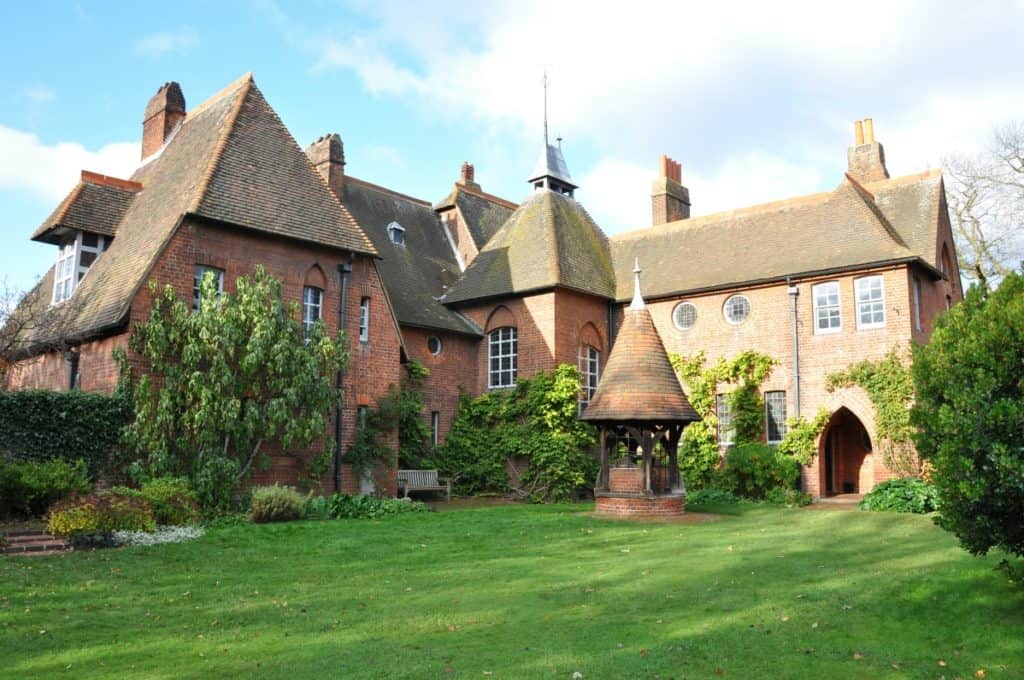
Reminiscent of a medieval relic, the Red House was designed in 1859 past Arts and Crafts designer William Morris and builder Philip Webb, in Bexleyheath, England. William Morris was greatly influenced past John Ruskin'due south reflections, who believed that the rise of industrialisation induced a qualitative decline in artistically crafted appurtenances. He endeavoured to fashion a home that would nurture harmony as well as infuse its inhabitants with a artistic energy. Morris and Webb's friendship led them to create a house in which architecture and interior pattern would alloy into a cohesive entity, reflecting their ideals in one overarching whole. The firm was designed in a simple Tudor Gothic style, and from the unique born furniture to the wallpaper, stained-drinking glass windows, and tiles inscribed with Morris'southward ain motto, the concept of the full work of fine art was dazzlingly embodied.
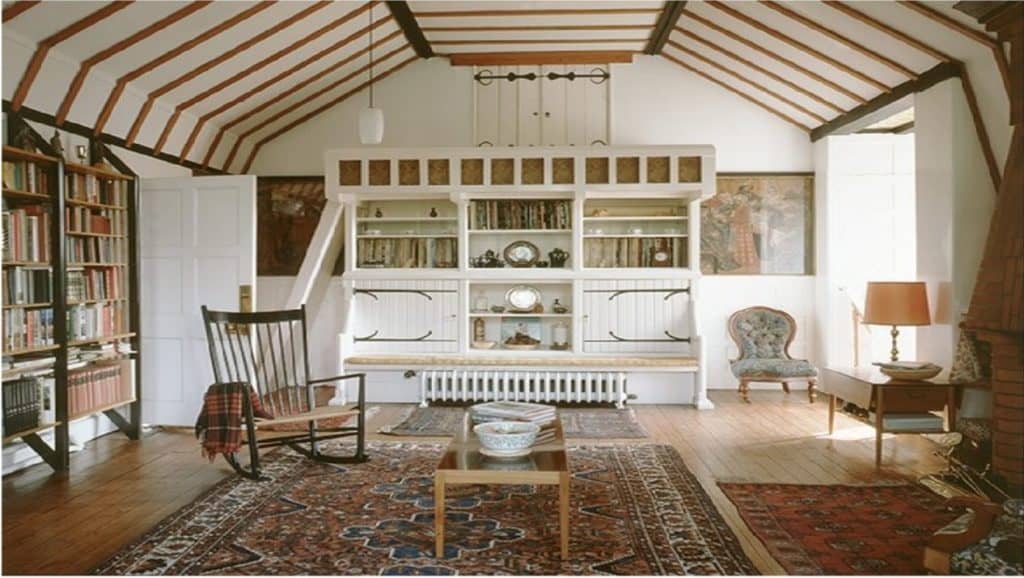
Victor Horta, Hôtel Tassel
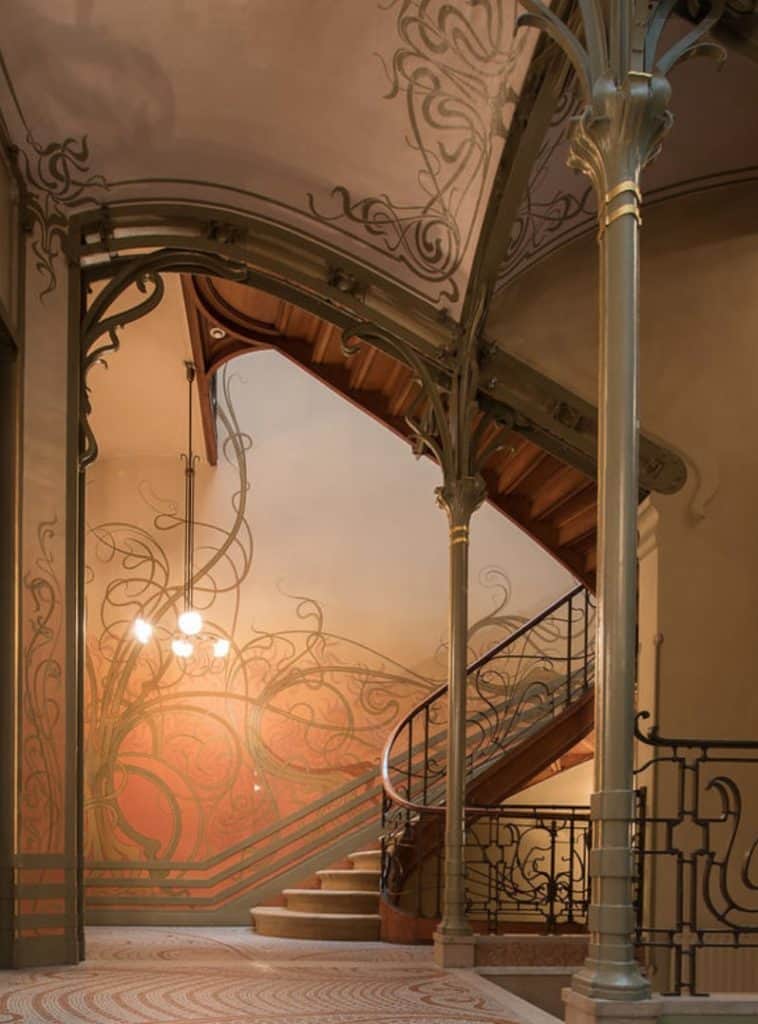
The Hôtel Tassel, or Tassel Business firm, is often considered to be one the showtime architectural illustrations of Art Nouveau. It integrated nature and industrial features in a seamless manner. Victor Horta designed The Tassel House for Émile Tassel, in Brussels, and completed it in 1893. Acting as architect, interior and article of furniture designer, Horta created a complete chef-d'oeuvre, harmonious in every aspect. Utterly unique in the fluidity of the curved lines and spiralling shapes echoing from the façade to the interior design, the firm is renowned for its grandiose multi-directional staircase. Horta's design was absolute and all-inclusive; piece of furniture, doors and handles, balustrades, house bell. The entirety of the interior and exterior elements reflected his desire to assemble with the purest unity, a total piece of work of art.
Antoni Gaudí, Casa Milà
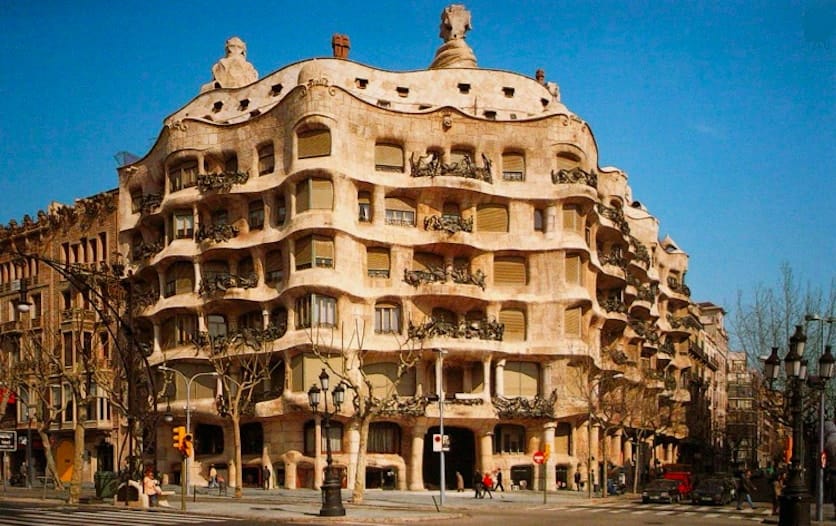
« In order for the decoration to be interesting, it must depict objects that bring to listen poetic ideas that plant motifs. The motifs draw on history, legends, icons, fables apropos human and his life, actions and passion. »
Antoni Gaudí
Constructed between 1906 and 1912 for Pere Milà and Roser Segimon, Casa Milà is Catalan architect Antoni Gaudí's nigh allegorical work of civil architecture. Labelled "La Pedrera", the quarry, due to its stony visage, Gaudí's piece of work is incredibly organic and close to nature. Architecturally, the building is divide into nine levels, the chief floor used to host the Milàs, while the upper floors would be rented out. Each of the apartments take their ain unique ceiling, some with relief and waves, others bearing poems, only all intended to reverberate the undulating features of the façade. Another exquisite outside space is the Surrealist sculptural roof terrace, with chimneys echoing the wavy rhythm of the building. Gaudí likewise took ownership of the interior details, from choosing the artwork to fashioning doorknobs and handles.
Charles Rennie Mackintosh, Willow Tea Rooms
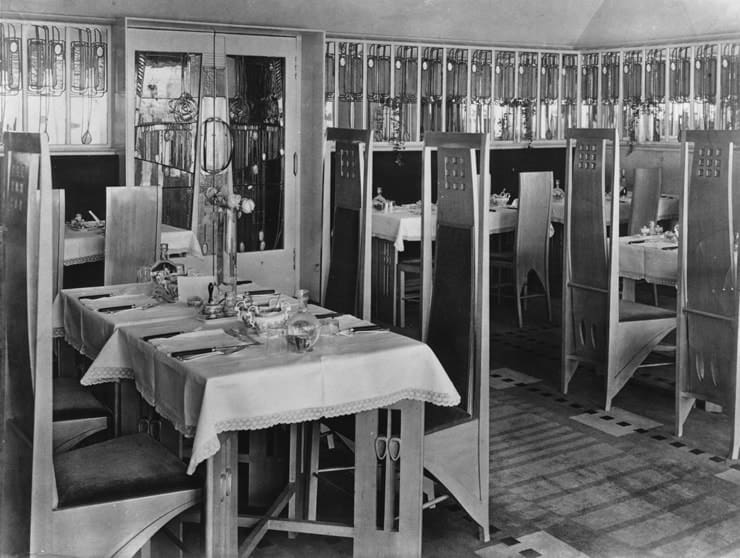
The Willow Tea Rooms were established in Glasgow in 1903, designed by Charles Rennie Mackintosh. Mackintosh was a Scottish architect, designer and creative person and tagged every bit "the design dictator" as a result of his desire to always mastermind the entirety of a project. To brainstorm Mackintosh remodelled an 1860s edifice; the exterior façade was modernized, delving into early Fine art Nouveau ideas. Mackintosh worked with his married woman, Margaret Macdonald, to blueprint the interiors. This included the furniture, wall decorations and friezes, as well as the carpets and chandeliers; paying crucial attention to the smallest details such as creating bespoke cutlery and fashioning the staff's uniforms, resulting in 1 of the near uncompromising of all Gesamtkunstwerk projects of the early modern, or any, era.
Walter Gropius, Bauhaus Dessau Edifice
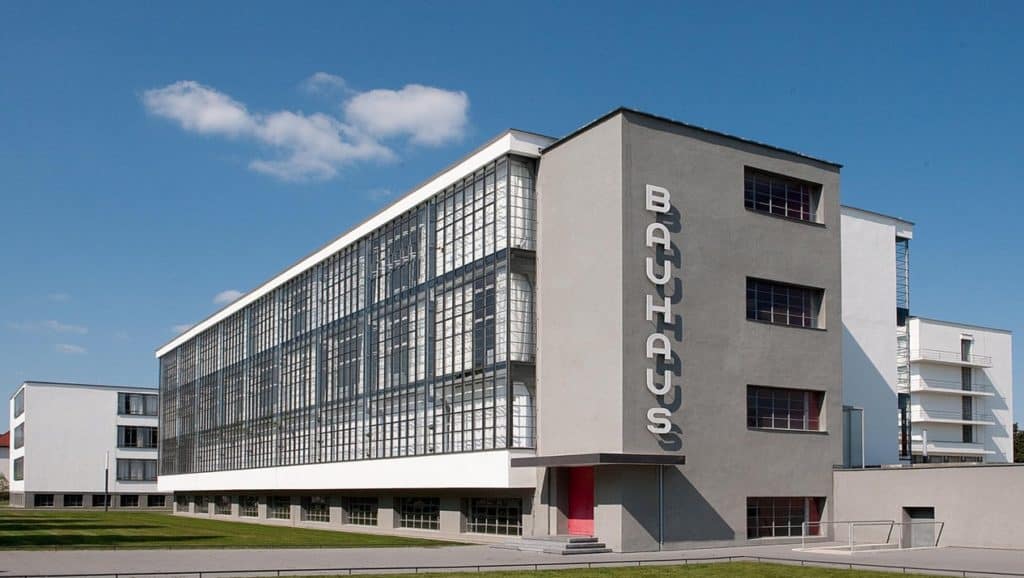
Few movements embraced the philosophy of Gesamtkunstwerk as meticulously every bit the Bauhaus did under the leadership of Walter Gropius. With the Bauhaus, Gropius aimed to unite all arts, including architecture. He famously reformulated the "total work of art" into "Total Blueprint", eager to convey this idea into all aspects of modern life. Subsequently relocating to the city of Dessau in 1925, Walter Gropius designed the schoolhouse'southward building in total accordance with the movement's values. All interior fittings and furnishings were designed in the school's ateliers. The virtually remarkable features of the Bauhaus Dessau building are the wrapping glass exterior walls, simultaneously supporting the structure and permitting a glimpse into the schoolhouse'south interiors. This was a further evolution of the Fagus factory, designed by Gropius pre-World State of war I.
Gerrit Rietveld, Schröder House
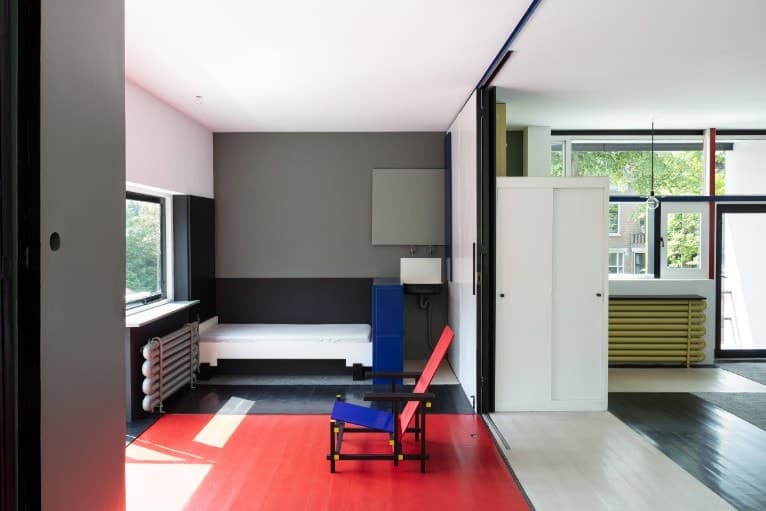
The De Stijl movement was highly influenced by the principles of Gesamtkunstwerk. Although primarily renowned for producing paintings, members of De Stijl also experimented with piece of furniture design and architecture, including the Schröder House. Designed in 1924 past Gerrit Rietveld, the Schröder Business firm remains the most iconic and emblematic architectural highlight of De Stijl, moulded in total accordance with the movement's principles. The main characteristics and uniqueness of the Rietveld-Schröder Firm reside in an overly flexible infinite, with an open-plan design on the ground floor and a system of sliding panels in the upstairs area, analogous to the rectilinear elements of the De Stijl'southward painting archetype. This would permit fluidity and an endless transformation of the infinite. The sole use of master colours together with black, gray and white is continuous from the outer walls to the inner elements of the house. This inspired harmony and truthfully consort the De Stijl artful ideals, making it one the all-time examples of modern Gesamtkunstwerk.
Le Corbusier, Villa Savoye
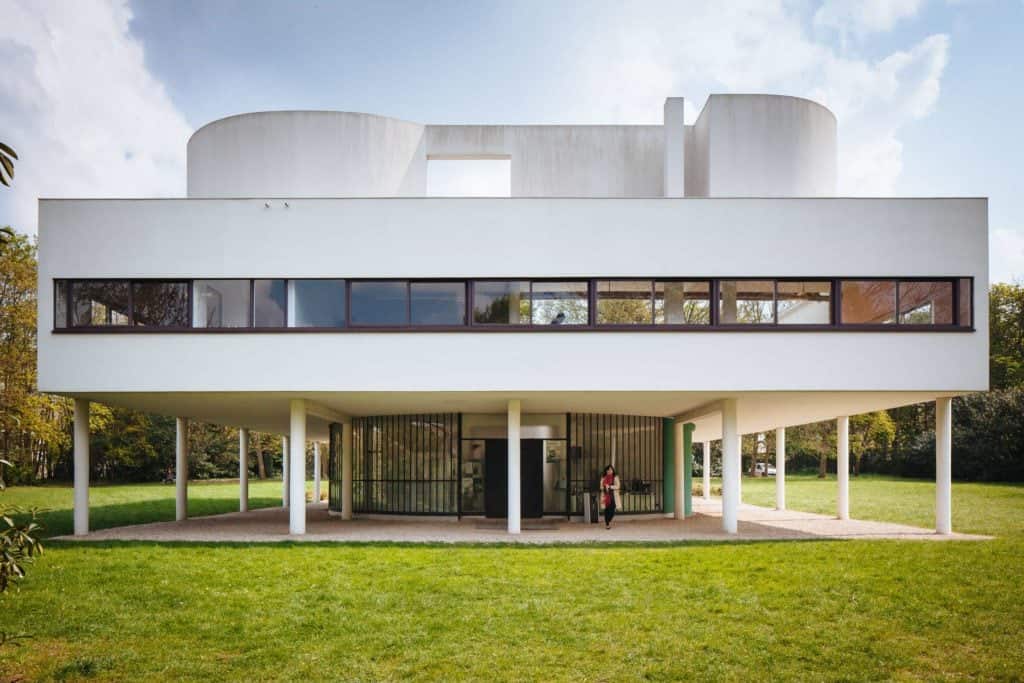
The Villa Savoye is oftentimes considered as Le Corbusier'due south masterpiece, the result of a decade spent defining the substance of modernistic architecture. Completed in 1929, the business firm embodies the ideals of Gesamtkunstwerk considering it is in its very essence, a total concept. Le Corbusier was granted accented creative freedom and designed his ain Modernist version of a typical French state home, a total image of his celebrated 5 Points of Architecture. Often referred to as a floating box, Villa Savoye'south most distinctive features are the pilotis supporting the whole construction. The interior is defined past an utterly elegant blend of functionality and minimalism, and a methodically idea out layout. The essence of the full artwork is experienced through a sense of unity, equally the characteristics of the outside structure are echoed in the shape of the furniture and staircases, designed past him in collaboration with his brother Pierre and Charlotte Perriand.
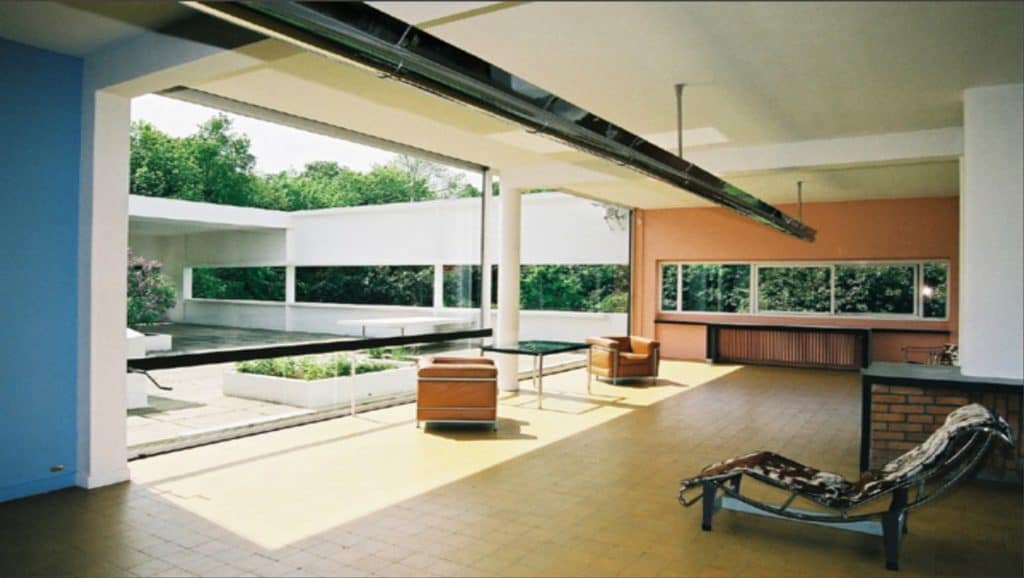
Frank Loyd Wright
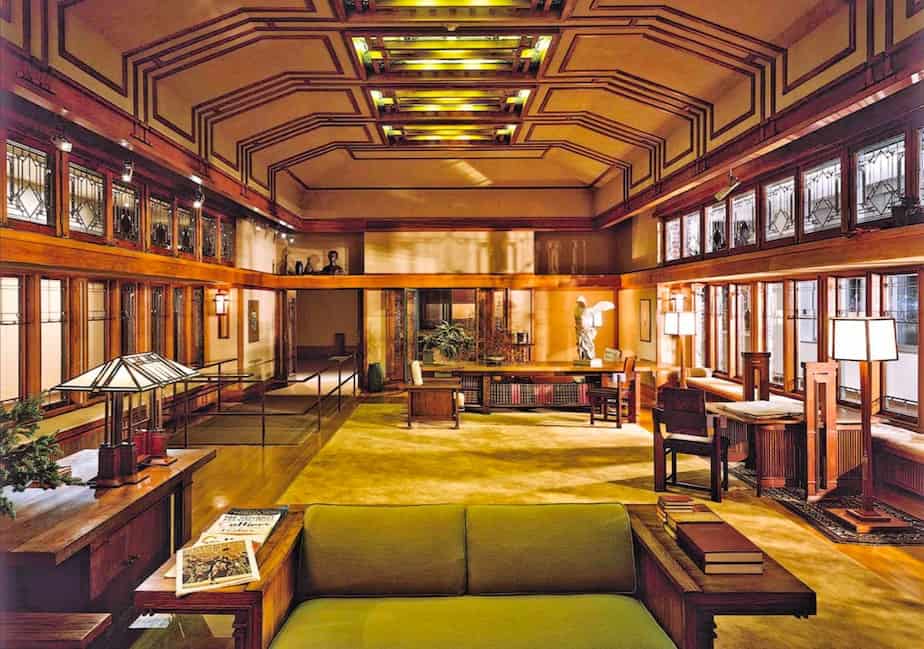
"The architect non only sees more than or less conspicuously the nature of the materials merely, in his ain trained imagination and past virtue of his own feeling, he qualifies it all every bit a whole."
Frank Lloyd Wright
Frank Lloyd Wright was one of America's greatest and nearly prolific architects, and a fervent abet of Gesamtkunstwerk. He was notorious for his complete involvement in all aspects of his projects, which was ofttimes considered as verging on narcissism, an offshoot of his rather egocentric personality. Wright's Prairie-style originated most notably with the Robie Business firm, a complete work of fine art completed in 1910, with its low ceilings and open interior stunningly capturing the landscapes of the Midwest. The architect took buying of the whole design, including the furniture, lite fixtures, as well equally the stained-drinking glass windows. Wright strongly believed in a unification of architecture with its natural environment, which he sumptuously achieved with his near acclaimed project, Fallingwater. Stood over a waterfall, the house echoes the organic pattern of the rock ledges, embracing the natural globe in a state-of-the-fine art architecture. Not many designs have succeeded in capturing such a strong sense of harmony between nature and mankind.
Zaha Hadid, Capital Hill Residence
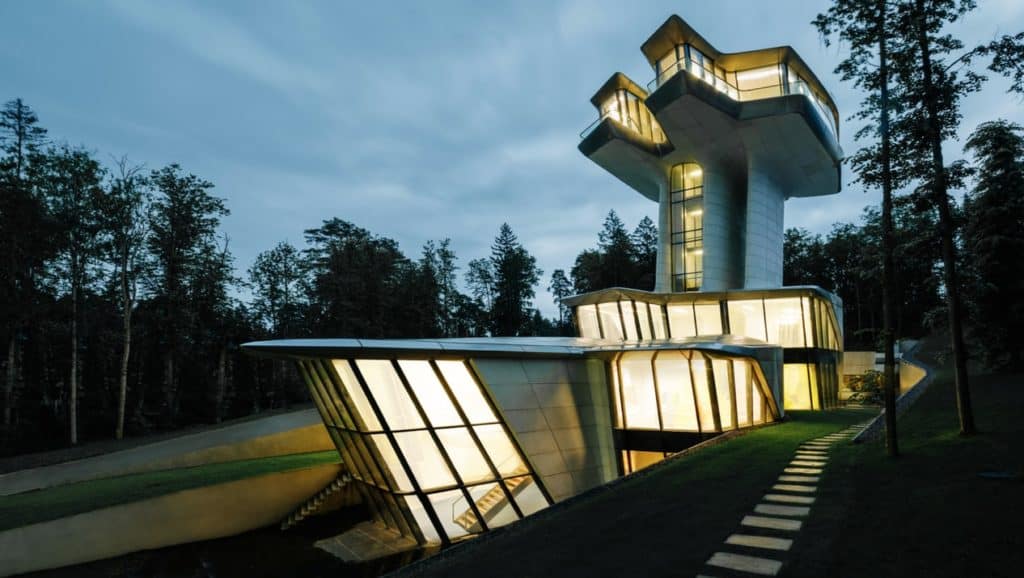
Few contemporary architects accept pioneered such iconic designs as Zaha Hadid. From her magnificent, cutting-edge buildings, to glorious interior pattern objects and furniture, Hadid's style has always been inspired by the fluidity of nature. The Capital Hill Residence is a remarkable example of a consummate work of art, and the merely private residence Hadid has always entirely designed and congenital. Hadid first came upwards with her center-catching design in 2006, and the projection was completed in 2018. Resembling a futuristic spaceship, the house is composed of ii principal components. The ground level department unites with the landscape, while the other about floats in a higher place the ground, offering a spectacular view of the surrounding wood. Hadid's feature style and outstanding craftsmanship are also featured throughout the interiors, as the organic, curved elements are echoed in the different rooms and interior design. Both Hadid and her client, Vladislav Doronin, have chosen the Capital Loma Residence a "Dream business firm", equally it exists simultaneously in their fantasies and in the tangible globe.
Relevantsources to acquire more than
Read more about Gesamtkunstwerk on The Fine art Story
Reflections on architectural Gesamtkunstwerk
Acquire more most Zaha Hadid
Source: https://magazine.artland.com/gesamtkunstwerk-the-total-work-of-art-through-the-ages/